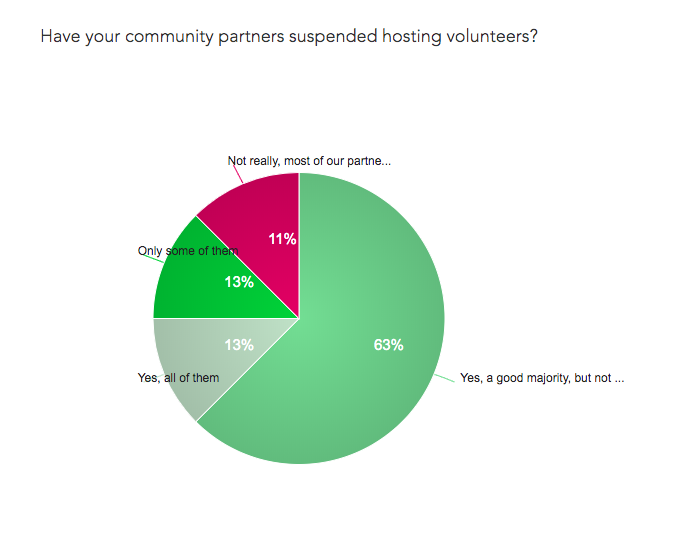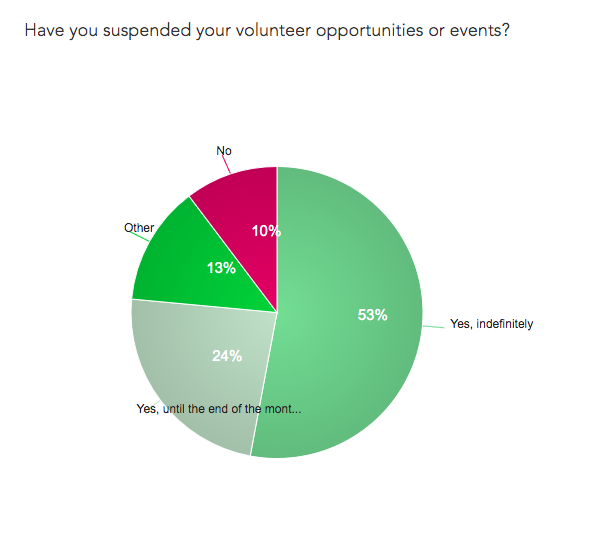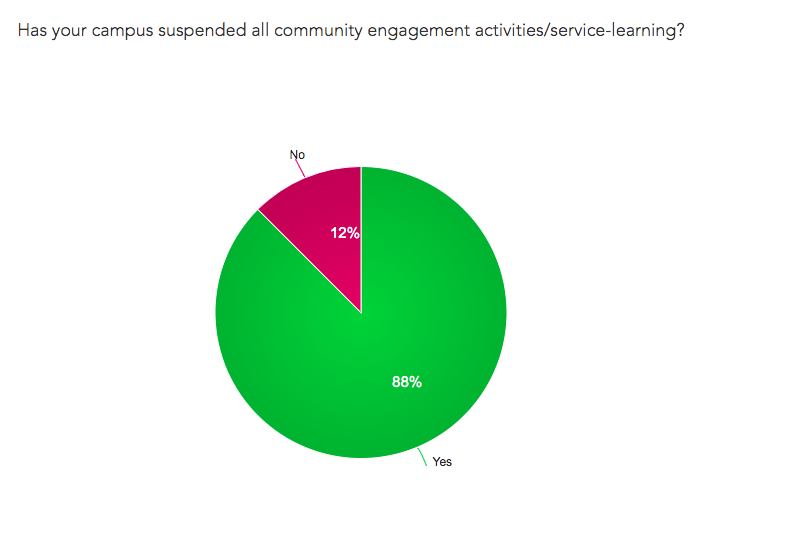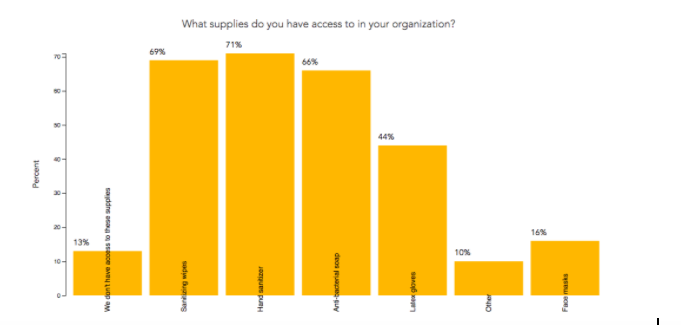Last week, as communities adjusted to updates about COVID-19, GivePulse asked partners to share information about the changes they are making to respond to this public health crisis. Thanks for the responses from so many of you. We hope that sharing this pandemic volunteerism data data might be useful for a broad range of allies wanting to take tangible action in their communities, now and moving forward. As we speak, we see many institutions and partners collaborating and learning from each other.
Additionally, in response to feedback and conversation with many of you, we were encouraged to do the following:
- Open this assessment to the broader higher education community and their partnerships for feedback and improvements
- Share back out the insights and analysis of the ensuing pandemic volunteerism data
- Collectively identify how to collaborate with partners to help scale their efforts, virtually or not, to assist those in impacted populations
We appreciate all institutions who respond to this assessment and provided this essential pandemic volunteerism data. Those who want to participate now can navigate to the link provided. We have updated the assessment to include a few public health questions to gauge the challenges and gaps as it relates to community engagement activity.
Data on these assessments will be anonymized and shared publicly for the benefit for the community. We’ll also make sure to monitor and provide an analysis of any further pandemic volunteerism data to facilitate further discussions, brainstorms, and video conferences to help each other navigate this changing landscape. We look forward to offering future webinars on the intersectionality of public health and community engagement in the weeks ahead.
In upcoming blog posts, we will be focused on providing information about best practices and sharing stories highlighting how communities are coming together at this time. If you have stories you would like us to share and highlight, please send them to blog@givepulse.com.
Here are some highlights from the responses we received to last week’s surveys:
Community partners are still hosting volunteers — and are impacted by students leaving campus

Only 13% of campus respondents reported that all community partners had suspended hosting volunteers; the remaining 87% had at least some partnerships still hosting volunteers in person. Since all of the responding campuses said that classes had been moved online — whether temporarily or until the end of the spring semester — this means that the movement of students away from campus leaves many organizations in need of volunteers.
Possible responses: Campuses are responding in a variety of ways. Some are asking that able and well faculty/staff volunteer; others are allowing students to continue volunteering if they wish to do so and the community partner agrees. Many are moving their focus to alternative opportunities such as research, content creation, assistance with blood drives, virtual connection, and more in order to continue supporting community partners. Read on for further suggestions of virtual/remote volunteering ideas.
The majority of nonprofit respondents have suspended volunteer opportunities or events — but those who still need volunteers are struggling to find them

NPO responses — nearly a quarter of respondents indicated that they have not suspended all volunteer opportunities
While the majority of organizations have suspended volunteer opportunities and events, indefinitely or for a defined period of time, those who have not are particularly hurting. Often, volunteers are retired adults — precisely those who are most vulnerable to coronavirus. In addition, general concern about spreading and catching coronavirus has impacted willingness to engage in the community. Because of this, shortages of volunteers are a real issue.
Possible responses: First and foremost, organizations should speak with local city/health officials about any engagement they are considering, given the unprecedented nature of this crisis. Make sure that any opportunities adhere to city guidance and regulations to maintain the wellbeing of your community. Generally, we suggest that you take the following steps for volunteer safety:
- Ask vulnerable volunteers to stay at home
- Make sure that information about symptoms and risk factors is widely available
- If volunteers are able to engage, deploy in limited and targeted manners to minimize risk
- Make sure that liability forms and waivers are updated
- Check in with volunteers and clients to ensure they are fully informed about proper protocol such as maintaining six feet of physical distance, washing hands regularly, and taking other responsible safety measures
Forms of volunteering that might be particularly amenable to those practicing physical distancing include park clean-up opportunities, which can be undertaken as an individual or as a group so long as the proper distance is maintained (please note that proper distance may depend upon your city/state; again, reach out to local officials to ask about any plans you are considering); food delivery; donations and online fundraising campaigns; and fostering of pets — if you are in quarantine, now is the perfect time to take in an animal that could benefit from your consistent love and attention!
Donations of money, food, supplies, and blood are depleted

While only 13% of organizations don’t have any supplies; ideally, all or most would have access to all of these critical safety measures. Less than half have access to gloves; less than three-quarters have access to hand sanitizer. Some reported running low even on soap and paper towels, as they are running through cleaning supplies at an unprecedented pace.
Some nonprofits are short on cleaning supplies such as hand sanitizer, disinfectant wipes, and even hand soap. This means that if they have in-person volunteers or clients, they cannot provide the necessary safety precautions to keep them well. Organizations that provide food to those in need — a group that has expanded as many vulnerable populations are encouraged to stay home from the grocery stores and restaurants — are in need of food and supplies, as well as volunteers for deliveries. Perhaps most striking was the number of organizations reporting severe decreases in their funds. This may be in part due to the fact that many have had to cancel major fundraising events.
Possible responses: Organizations have suggested that corporations looking for ways to give back, now and in the near future, utilize the corporate matching abilities of GivePulse — organizations will need to replenish funds and volunteers even after this pandemic is under control. Beyond this, nonprofits can start fundraising campaigns, seek in-kind donations, and organize meal deliveries. Reach out to our emergency response team (covid@givepulse.com) or our support team (support@givepulse.com) if we can help you match you to excess resources or to add your fundraising campaigns, for both money and for in-kind donations of food, supplies, etc.
Online classes mean changes to curriculum

Every campus responding said that they had moved classes online for some defined period of time, whether until the end of the spring semester or for another temporary defined time.
Every campus that responded to our survey has moved classes online for this time. For community based learning, this means a significant shift — classes can no longer be based on in-person engagement, typically the crux of a community based pedagogy. This has led campuses to consider solutions that will still work toward the same learning goals without putting students or communities at risk.
Possible responses: Institutions have offered a range of responses, but all align in that they offer greater flexibility to students and partners alike. Some campuses have waived all service learning requirements; others are allowing, but not requiring, virtual alternatives. Some are allowing students to continue working with their CPs and making decisions situation-by-situation. Overall, the switch to online classes has prompted a deeper focus on reflection and research. From researching social determinants that lead to the need for their partners’ work, to analyzing the impact of COVID-19 on these partners; from research papers to Zoom reflection meetings; from responding to civic dialogue prompts to watching educational videos and reading pertinent articles — curricula have changed to focus more deeply on reflections and on adaptability. Join our group to brainstorm with peers as this new situation continues to change.
Many organizations and institutions are looking for creative ways to shift to virtual volunteering
Based on our pandemic volunteerism data, many organizations are attempting to determine whether they can move some or all of their volunteering to remote/virtual activities. While many will still rely on hands-on engagement, others are working to come up with ways to engage volunteers who may be quarantining or isolating at this time.

Possible responses: Organizations and institutions have come up with a variety of creative virtual/remote opportunities, such as creation of educational materials, filmed reading aloud of children’s books, development of curricula, engagement in tutoring/mentoring over video conference if available, and more. In addition, translation of materials already available is necessary — if you speak multiple languages, reach out to the nonprofits you work with and see if you can help translate information both about the organization and about health/hygiene in this time into multiple languages. Other efforts include capacity building projects such as fundraising campaigns, social media efforts, and researching best practices and grants. For more ideas, join our group or visit our dedicated blog post!
Now is a great time to focus on civic engagement
With primaries and elections interrupted by calls for social distancing, maintaining a focus on civic engagement is more important than ever. While we do not know exactly how every state will respond to this crisis, we do know that this year’s election will be pivotal — perhaps even more so given the uncertainties of the time.
Possible responses: Campuses and organizations can help students, and those who anticipate that they will not be able to leave home to go to primaries, with absentee ballots. Students and volunteers can research and advocate for policy changes, particularly based on the events of this time. Voter registration initiatives will be of the utmost importance. We anticipate sharing some exciting new partnerships to help with this effort.
NPOs and campuses can be hubs for safety/wellness information, positive communication, and social connection
Access to information and to positive messaging is critical at this time; people need encouragement and will benefit from seeing the many incredible ways that our communities are coming together. If we have learned one thing from the responses we received, it is that our partners are working to connect with community members in need, devoting themselves in this time of crisis to the wellbeing of others. We look forward to highlighting these stories in the days and weeks ahead. NPOs and campuses can similarly highlight these stories, becoming hubs for the communication that will lift spirits and encourage safe practices going forward.
Possible responses: Many organizations are checking in individually with clients over phone call or video. Many are also sending emails and newsletters to share hygiene tips and safety practices, particularly if volunteers may be engaging with in-person volunteer opportunities. Promoting social connection even in this time of physical distancing, and facilitating volunteer connectedness, can create a strengthened sense of community.
GivePulse is dedicated to providing resources, facilitating discussions, and promoting connectedness. Part of our efforts to do so include the creation of COVID-19 forums for higher education admins and nonprofit admins. Please join these groups and introduce yourself on the discussion board; we look forward to working with all of you to best accommodate your needs and to encourage the creativity needed to help our communities thrive.
Our mission to transform everyone into engaged citizens has not changed at this time. We look forward to continuing to engage alongside all of our incredible partners. For support, assistance, brainstorming, or to discuss this pandemic volunteerism data, you can schedule a call with our success team.
To learn more about how GivePulse can help you make a difference in your community, schedule a call.

